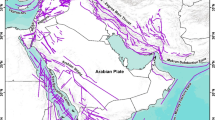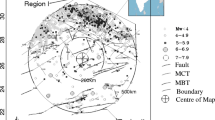Abstract
For mainland China, the primary obstacle in conditional spectrum (CS) based ground motion selection work is that the corresponding seismic hazard disaggregation results were not released for the China national standard GB 18306–2015 “Seismic Ground Motion Parameter Zonation Map”, which refers to the fifth-generation seismic hazard map. Therefore, this study firstly constructed a probabilistic seismic hazard map for mainland China using the three level seismicity source models as applied to produce the fifth-generation seismic hazard map. The derived peak ground acceleration (PGA) values in our seismic hazard map were basically consistent with the PGA range bins in fifth-generation seismic hazard map for most of the 34 principal cities considered. Then, a three-dimensional disaggregation scheme was performed for PGA and 5%-damped spectral acceleration (Sa) corresponding to mean return periods of 475 and 2475 years. The results clearly identified the potential source areas and corresponding fault zones that dominate the hazard of the target cities regarding different intensity measures. Based on the magnitude-longitude-latitude disaggregation results of three example cities: Xichang, Kunming, and Xi’an, approximate and exact CS were established with/without considering multiple casual earthquakes and possible strike directions of the potential source areas. The mean exact CS lies between the results of approximate CS using long and short axis GMMs. The conditional standard deviation of exact CS is approximately 1.1–1.5 times larger than the approximate CS for the periods away from the conditional period. For three example cities, hazard consistency of the spectral accelerations of the ground motion realizations were validated for matching exact CS and approximate CS. The results suggested that the geometric mean approximate CS without inflation of standard deviation is a practical choice when the target exceedance rate was not too low. Moreover, for the 34 studied cities, we tabulated the uniform hazard curve and disaggregation results for PGA and Sa values (0.2, 0.3, 0.5, 0.7, 1.0, 1.5, and 2.0 s) at mean return period of 475 and 2475 years (https://github.com/JIKUN1990/China-Seismic-Hazard-Deaggregation-34cities).









Similar content being viewed by others
Data availability
The results calculated in this study for 34 principal cities in mainland China are freely accessed on the open-source GitHub platform: https://github.com/JIKUN1990/China-Seismic-Hazard-Deaggregation-34cities
References
Baker JW (2011) Conditional mean spectrum: tool for ground-motion selection. J Struct Eng-ASCE 137(3):322–331. https://doi.org/10.1061/(asce)st.1943-541x.0000215
Baker JW, Cornell CA (2005) A vector-valued ground motion intensity measure consisting of spectral acceleration and epsilon. Earthq Eng Struct Dyn 34(10):1193–1217. https://doi.org/10.1002/eqe.474
Baker JW, Cornell CA (2006) Spectral shape, epsilon and record selection. Earthq Eng Struct Dyn 35(9):1077–1095. https://doi.org/10.1002/eqe.571
Baker JW, Jayaram N (2008) Correlation of spectral acceleration values from NGA ground motion models. Earthq Spectra 24(1):299–317. https://doi.org/10.1193/1.2857544
Baker JW, Bradley BA, Stafford PJ (2021) Seismic hazard and risk analysis. Cambridge University Press, Cambridge, p 668
Bazzurro P, Cornell CA (1999) Disaggregation of seismic hazard. Bull Seismol Soc Am 89(2):501–520
Bender B (1986) Modeling source zone boundary uncertainty in seismic hazard analysis. Bull Seismol Soc Am 76(2):329–341
Bradley BA (2010) A generalized conditional intensity measure approach and holistic ground-motion selection. Earthq Eng Struct Dyn 39(12):1321–1342. https://doi.org/10.1002/eqe.995
Bradley BA (2012) A ground motion selection algorithm based on the generalized conditional intensity measure approach. Soil Dyn Earthq Eng 40:48–61. https://doi.org/10.1016/j.soildyn.2012.04.007
China Earthquake Administration, CEA (2015) Seismic ground motion parameters zonation map of China (GB 18306-2015). Seismological Press, Beijing (in Chinese)
Cornell CA (1968) Engineering seismic risk analysis. Bull Seismol Soc Am 58(5):1583–1606
Gao M (ed) (2015) Publicizing materials of GB 18306–2015 Chinese ground motion parameter zoning map. China Standard Press, Beijing (in Chinese)
Harmsen SC (2001) Mean and modal in the deaggregation of probabilistic ground motion. Bull Seismol Soc Am 91(6):1537–1552. https://doi.org/10.1785/0120000289
Jayaram N, Lin T, Baker JW (2011) A computationally efficient ground-motion selection algorithm for matching a target response spectrum mean and variance. Earthq Spectra 27(3):797–815. https://doi.org/10.1193/1.3608002
Ji K, Ren Y, Wen R (2017) Site classification for national strong motion observation network system (NSMONS) stations in China using an empirical H/V spectral ratio method. J Asian Earth Sci 147:79–94. https://doi.org/10.1016/j.jseaes.2017.07.032
Ji K, Bouaanani N, Wen R, Ren Y (2018) Introduction of conditional mean spectrum and conditional spectrum in the practice of seismic safety evaluation in China. J Seismol 22(4):1005–1024. https://doi.org/10.1007/s10950-018-9747-8
Lin T, Harmsen SC, Baker JW, Luco N (2013a) Conditional spectrum computation incorporating multiple causal earthquakes and ground-motion prediction models. Bull Seismol Soc Am 103(2A):1103–1116. https://doi.org/10.1785/0120110293
Lin T, Haselton CB, Baker JW (2013b) Conditional spectrum-based ground motion selection. Part I: hazard consistency for risk-based assessments. Earthq Eng Struct Dyn 42(12):1847–1865. https://doi.org/10.1002/eqe.2301
Lu H, Zhao F (2007) Site coefficients suitable to China site category. Acta Seismol Sin 20(1):71–79. https://doi.org/10.1007/s11589-007-0071-6
Lu DG, Liu T, Li S, Jia X, Pang J, Yu X (2017) Probability seismic hazard analysis, deaggregation and scenario earthquake with application to Xi’an region. Earthquake Engineering and Engineering Dynamics 38(5):12–21 (in Chinese with English abstract)
McGuire RK (1995) Probabilistic seismic hazard analysis and design earthquakes: closing the loop. Bull Seismol Soc Am 85:1275–1284
Ministry of Housing and Urban-Rural Construction of the People's Republic of China (MHURC) (2016) Code for seismic design for buildings (GB 50011-2010) 2016 edition. China Architecture & Building Industry Press, Beijing (in Chinese)
National Research Council (NRC) (1988) Probabilistic seismic hazard analysis, in report on the panel on seismic hazard analysis. National Academy Press, Washington D.C
Pagani M, Monelli D, Weatherill G, Danciu L, Crowley H, Silva V, Henshaw P, Butler L, Nastasi M, Panzeri L, Simionato M, Vigano D (2014) OpenQuake engine: an open hazard (and risk) software for the global earthquake model. Seismol Res Lett 85:692–702. https://doi.org/10.1785/0220130087
Wen R, Ji K, Ren Y (2018) The real ground motion records selection for seismic design code in China. In: 16th European Conference
Yu Y, Li S, Xiao L (2013) Development of ground motion attenuation relations for the new seismic hazard map of China. Technol Earthq Disaster Prev 8:24–33 (in Chinese with English abstract)
Zhou BG, Sun JB (2000) Advances in delineation of potential seismic sources in China. J Earthq Predication Res 8(1):92–103 (in Chinese with English abstract)
Acknowledgements
The authors are very grateful to Professor Bradley. B. A. and another anonymous reviewer for their important and valuable comments which helped to improve the paper. The authors are grateful to the associate researcher Dr. Changlong Li for providing useful guidance regarding the construction of the China hazard map. The open-source Generic Mapping Tools (GMT) software was used to produce some of the figures in this paper. The OpenQuake Platform (https://platform.openquake.org/) developed by the GEM Foundation is acknowledged for the hazard assessment work in this study (Pagani et al. 2014).
Funding
This work was partly supported by the Chinese National Natural Science Fund (Grant Number: 51908518). Heilongjiang Provincial Natural Science Foundation of China (Grant Number. LH2020E022); Preferential funding for returned overseas Chinese Scholars in Heilongjiang; Science Foundation of the Institute of Engineering Mechanics, CEA (Grant Number. 2019B09);
Author information
Authors and Affiliations
Corresponding author
Ethics declarations
Conflict of interest
All authors certify that they have no affiliations with or involvement in any organization or entity with any financial interest or non-financial interest in the subject matter or materials discussed in this manuscript.
Additional information
Publisher's Note
Springer Nature remains neutral with regard to jurisdictional claims in published maps and institutional affiliations.
Appendix
Appendix
Formula derivation for Eqs. (9) and (10)
For kth seismic source grid point, \(f_{k} (x)\) is the conditional probability density function(PDF) of ln Sa(Ti) given ln Sa(T*). Supposing that there are two possible strike directions: strike direction α and strike direction β. The corresponding conditional PDFs were defined as \(f_{k1}^{{}} (x)\) and \(f_{k2} (x)\) respectively.
in which, \(\mu_{{\ln Sa_{k1} (T_{i} )|\ln Sa(T^*)}}\) is denoted as \(\mu_{k1}\), \(\mu_{{\ln Sa_{k2} (T_{i} )|\ln Sa(T^*)}}\) is denoted as \(\mu_{k2}\), defination of them could be found in Eqs. (6) and (7). \(\sigma = \sigma_{k1} = \sigma_{k2} = \sigma_{{\ln Sa_{k} (Ti)|\ln Sa(T^*)}}\), which is defined in Eq. (8).
g(x) is The conditional PDF of \(\ln Sa(Ti)|\ln Sa(T^*)\). It could be obtained via the total probability theorem form as follows.
Then \(\mu_{{\ln Sa(T_{i} )|\ln Sa(T^*)}}\) could be derived as:
\(\sigma_{\ln Sa(T_{i})|\ln Sa(T^*)}\) could be derived as:
in which
Rights and permissions
About this article
Cite this article
Ji, K., Wen, R., Ren, Y. et al. Disaggregation of probabilistic seismic hazard and construction of conditional spectrum for China. Bull Earthquake Eng 19, 5769–5789 (2021). https://doi.org/10.1007/s10518-021-01200-2
Received:
Accepted:
Published:
Issue Date:
DOI: https://doi.org/10.1007/s10518-021-01200-2




